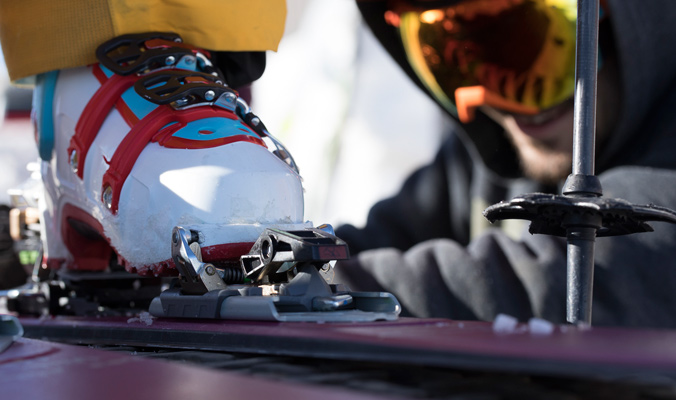It’s a brave new world of AT boot design on the winter 2019 skintrack, but with options like shell moldability, four buckles or no buckles, flex ratings up to 130 and weights ringing in at a scant 3.9 lbs., picking the right boot for conditions and terrain can be as hard as finding your soulmate on Tinder. So we’ve broken down a few key design and fitting concepts to help you swipe right on the best boot for you.

Testers try all shapes, flexes and buckle orientations at Gear Test Week 2019. [Photo] Matt Kiedaisch
The Boot Gap: Is a boot quiver necessary?
From eight-pound four-bucklers to three-pound skimo sneakers, there are now more AT boot options than you can shake a ski pole at. With so many specialty offerings available, does it make sense to own a backcountry boot quiver?
Consult your checking account and bootfitter first. While you’re at it, heed some of advice from our testers, who are seeing more crossover than ever before in AT boots—that is to say, many of today’s boots are capably covering a variety of pursuits and interests, either outfitting slender statures with ample power or mating sturdy silhouettes with wide walk modes.
“Downhill-focused touring boots are closing the gap with ultralight options while offering superior skiing performance,” says Jason Layh, of Tahoe City, Calif., who chose the Dynafit Hoji Pro Tour and Tecnica Zero G Tour Pro as his test top choices.
Eric Tiffany, who ranked the 115-flex Scott Cosmos III alongside the 130-flex Rossignol Alltrack Elite among his favorites, agrees: “Four-buckle boots are getting better in terms of weight and range of motion, and the middleweight boots are really capable of long-distance touring and driving a decent-skiing ski.”
What to choose if a quiver seems superfluous or isn’t in the budget? Consider where your interests lie and what types of tours you do most—are you focused more on the ascent or descent or do you wish to balance both equally? Check out the glossary in the back of the Gear Guide to see where each of the boots reviewed fall on an up-versus-down scale. And know that, as things continue to improve, backcountry boots are becoming increasingly capable of doing most things well.
Buckle Down: Where have all the buckles gone?
Choosing a backcountry boot once relied on a simple formula. Four buckles trimmed the stiffest, heaviest options; boots that balanced tourability with descending capabilities featured three buckles; and those with one or two were dedicated to the skintrack, saving weight and offering unrestricted walk modes. Today, that correlation doesn’t exactly compute.
Look at Dynafit’s Hoji Pro Tour, for example—it’s fairly stout, with a 120 flex. Dynafit says it’s “as rigid as an alpine boot,” and tester feedback generally concurred, enough to earn the boot an Editors’ Choice Award. But the Hoji has just three buckles, two of which hardly even look like conventional clasps.
Brands are dropping buckles, favoring strategic placement and clever designs to do more with less. Opening the Hoji’s walk mode simultaneously releases the power strap and top buckle; four boots tested this year incorporated a Boa system, which employs a ratcheting dial to cinch a wire that can be threaded through numerous contact points for lace-like security; and Scarpa’s two-time Editors’-Choice-winning Alien RS doesn’t even have buckles.
“More boots using Boa over the instep make my feet happy,” says Jaime Krakowiak of Breckenridge, Colo., who chose the Alien RS as her favorite boot this year. Bozeman, Mont.-based Christine Raymond, who selected both Scarpa’s Alien RS and their F1 as her picks, appreciated all the low-profile adjustments—once she got used to them: “Complicated, but sweet.”So when shopping for boots, don’t make assumptions based on the number of buckles—consider flex, walk-mode range, ergonomics and, most importantly, fit.
—
Find out more about boot options for 2019 in the Backcountry Magazine Gear Guide, on sale here.











Can anyone give me guidance about women’s telemark 75mm boots? Which company is making the widest boots?
My old Garments are finally wearing out, but the new Garment/Scotts are too narrow for me. Ideas?
I thought this article was going to be about “fit”…
I shouldn’t have expected that much detail from this magazine
If you are looking for more in-depth suggestions on boot fitting, I suggest talking a look at our interview with Master Bootfitter Bob Egeland, here: https://backcountrymagazine.com/gear/fabulous-feet-master-bootfitter-bob-egeland-talks-approach-boot-fitting/